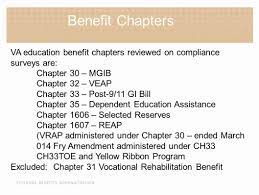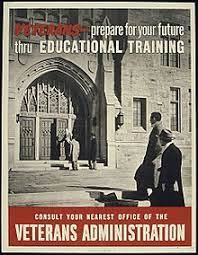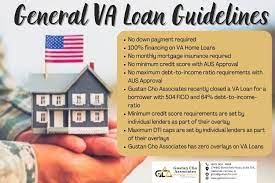VA Education Benefits: Helping Veterans Achieve Their Educational Goals
For veterans who have served our country, the transition to civilian life can be challenging. One of the biggest challenges is finding a new career path, which often requires additional education or training. Fortunately, the Department of Veterans Affairs (VA) offers a variety of education benefits to help veterans achieve their educational goals and transition into civilian careers.
The VA education benefits program provides financial assistance to eligible veterans and their dependents who are pursuing higher education or training. These benefits can be used for a variety of educational programs, including traditional college degrees, vocational and technical training, apprenticeships, and on-the-job training.
One of the most popular VA education benefits programs is the Post-9/11 GI Bill. This program provides up to 36 months of educational benefits to eligible veterans who have served on active duty for at least 90 days after September 10, 2001. The benefits include tuition and fees payments directly to the school, a monthly housing allowance based on the location of the school, and a stipend for books and supplies.
Another VA education benefit program is the Montgomery GI Bill (MGIB). This program provides financial assistance to eligible veterans who have served on active duty for at least two years. The MGIB offers up to 36 months of educational benefits that can be used for degree programs, vocational and technical training, apprenticeships, and on-the-job training.
In addition to these two main programs, there are other VA education benefit programs available that may be better suited to certain individuals’ needs. For example, there is a program specifically designed for veterans with service-connected disabilities called Vocational Rehabilitation and Employment (VR&E). This program provides assistance with job training, employment accommodations, resume development, and job-seeking skills coaching.
To apply for VA education benefits programs, veterans must first determine their eligibility by visiting the VA’s website or contacting their local VA office. Once eligibility is established, veterans can apply online using the VA’s eBenefits portal or by submitting a paper application to their local VA office.
Overall, VA education benefits are an excellent resource for veterans who are looking to further their education and training. These benefits can help veterans achieve their career goals and successfully transition back into civilian life. If you are a veteran or a dependent of a veteran, be sure to explore the many education benefit programs offered by the VA and take advantage of this valuable resource.
Your Guide to VA Education Benefits: FAQs Answered
- How do I check my VA education benefits?
- How much is the monthly stipend for VA education benefits?
- What does VA educational benefits mean?
- What are the types of VA education benefits?
How do I check my VA education benefits?
If you are a veteran or a dependent of a veteran who is receiving VA education benefits, you can check the status of your benefits by following these steps:
- Visit the VA’s website at www.va.gov and log in to your account using your DS Logon, My HealtheVet, or ID.me credentials.
- Once logged in, click on the “Education” tab and select “Manage Your Benefits.”
- From there, you will be able to view information about your current benefit status, including the amount of benefits you have used and how much is remaining.
- You can also view your payment history and update your personal information, such as your mailing address or bank account information for direct deposit.
If you do not have an account on the VA’s website yet, you can create one by clicking on the “Sign In” button at the top right corner of the homepage and selecting “Create an Account.” You will need to provide some personal information to verify your identity before creating an account.
Alternatively, you can contact the VA’s Education Call Center at 1-888-442-4551 to check on the status of your benefits or ask any questions you may have about VA education benefits programs. The call center is open Monday through Friday from 8:00 am to 7:00 pm EST.
How much is the monthly stipend for VA education benefits?
The monthly stipend for VA education benefits varies depending on the specific program and the location of the school. For example, under the Post-9/11 GI Bill, the monthly housing allowance is based on the Basic Allowance for Housing (BAH) for an E-5 with dependents in the zip code where the school is located. The BAH rate can vary widely depending on location, so the monthly stipend can range from a few hundred dollars to over $3,000.
It’s important to note that there are also other factors that can affect the amount of the monthly stipend, such as whether you are enrolled full-time or part-time and whether you are pursuing an online or in-person degree. The best way to determine your specific monthly stipend amount is to use the GI Bill Comparison Tool provided by the VA, which takes into account all of these factors and provides an estimate of your benefits based on your individual circumstances.
What does VA educational benefits mean?
VA educational benefits refer to the financial assistance provided by the Department of Veterans Affairs (VA) to eligible veterans and their dependents who are pursuing higher education or training. These benefits can be used for a variety of educational programs, including traditional college degrees, vocational and technical training, apprenticeships, and on-the-job training. The VA offers several education benefit programs, including the Post-9/11 GI Bill, Montgomery GI Bill, and Vocational Rehabilitation and Employment program. These programs provide financial assistance to eligible veterans to help them achieve their educational goals and transition into civilian careers. Eligibility for these programs varies depending on factors such as length of service, type of discharge, and disability status.
What are the types of VA education benefits?
There are several types of VA education benefits available for veterans and their dependents. These include:
- Post-9/11 GI Bill: This program provides up to 36 months of educational benefits to eligible veterans who have served on active duty for at least 90 days after September 10, 2001. The benefits include tuition and fees payments directly to the school, a monthly housing allowance based on the location of the school, and a stipend for books and supplies.
- Montgomery GI Bill (MGIB): This program provides financial assistance to eligible veterans who have served on active duty for at least two years. The MGIB offers up to 36 months of educational benefits that can be used for degree programs, vocational and technical training, apprenticeships, and on-the-job training.
- Vocational Rehabilitation and Employment (VR&E): This program provides assistance with job training, employment accommodations, resume development, and job-seeking skills coaching to veterans with service-connected disabilities.
- Dependents’ Educational Assistance (DEA): This program provides educational assistance to spouses and children of veterans who are permanently and totally disabled due to a service-related condition or who died while on active duty or as a result of a service-related condition.
- Fry Scholarship: This program provides educational benefits to surviving spouses and children of service members who died in the line of duty after September 10, 2001.
- Yellow Ribbon Program: This program allows institutions of higher learning (IHLs) in the United States to voluntarily enter into an agreement with the VA to fund tuition expenses that exceed the highest public in-state undergraduate tuition rate.
Each type of benefit has its own eligibility requirements, application process, and benefit amounts. Veterans should explore all available options carefully to determine which program best suits their needs.




